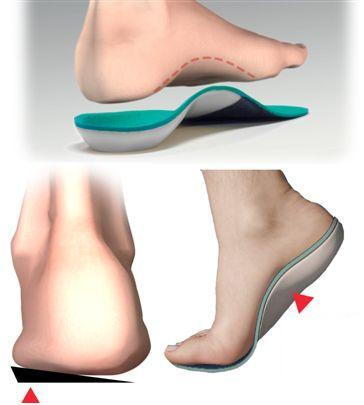
Foot, Ankle, Knee, and Lower Back Pain
The foot and ankle impact on the health of your body significantly. One doesn’t realize that instability of the foot and ankle can lead to painful skeletal alignment issues. At University Foot & Ankle Specialists, prescription orthotics insoles help to relieve the pain and discomfort caused by an unsupported foot during everyday activities, sports activities and long hours standing at work.
Taking the right steps.
Everyone walks a little differently but most commonly. During normal gait cycle the heel will touch the ground first with each step. Then you roll over the ball of your foot and onto your toes. With each move, your heel swings from side to side; the big toe maintains balance while the smaller toes act as a springboard. But if your heel swings too much, the foot may flatten more than it should and over time, these abnormal movements may cause imbalance and foot problems. Prescription custom orthotics will limit or assist motion by altering the way the bones and muscles work when one is walking or running.
What causes foot problems?
Foot and ankle problems are responsible for causing a wide range of health problems. Some common foot problems are bunions, hammertoes, knee, hip, children’s growth pain, corns, callous, ball of foot pain, shin pain, and heel pain.
The solution? A possible alternative to surgery and medication.
Most people have three types of feet - arched, high arched and flatfeet. A large percentage of the the general population is flat-footed, i.e. no arch is present under the foot. People with flatfeet are exposed to greater level of risks with a higher chance of developing strained muscles, weakened muscles, sprained ligaments, and other pains as a result of its fallen arch. However, based on these conditions, there is a good chance to treat children aged from 5 to 15 years old with flatfoot as the arch can still be supported with the use of custom prescription insoles.
Prescription orthotics insoles and proper footwear can provide relief for flatfeet, ankles, knees, and the lower back. However, for people with high arched feet or excessive pronation, it is most likely developed due to bone or neurological conditions related to the nerves. In high arched feet, the arch may or may not lower during walking and running and the ankles will tend to twist inwards. Unlike flat feet, high arches put more stress is placed on the metatarsals or ball of the feet which can cause pain. Prescription orthotic therapy is ideal for people that have high arches. The majority of people that do have prescription orthotics are able prevent unnecessary surgical procedures and medications.
Rx Orthotics Insoles & Shoes. How do they work?
Prescription custom orthotics are designed to correct faulty foot function and alignment during the gait cycle. This is like driving a car with poor alignment destroying tires and wearing down on car suspension parts. Custom orthotics not only help alleviate problems in the feet but also in other parts of the body such as the knees and lower back.
What different types of orthotics are available?
Generally, there are 2 types of orthotics: prescription custom orthotics and pre-made over the counter orthotics. While the latter is readily available, custom made orthotics can only be properly evaluated, prescribed, dispensed by a Podiatrist. Custom made orthotics insoles are prescribed for patients with specific problems.
Other counter orthotics is a big business at fitting the general population; however, when having specific foot problems i.e. plantar fasciitis, flatfeet, high arched feet, knee, hip, back pain they are poorly made devices. Due to the unregulated nature of over the counter orthotics, there is no standard. The difference between custom orthotics and over the counter sometimes is like driving luxury car versus an economy car. Aren’t your feet worth it? =)
Good footwear is important.
The next time you buy a pair of shoes; have your feet measured and use the arch length measurement. It is best to go shoe shopping in the afternoon as that is the time when one’s feet swell.
The soles of the shoes should be strong with flexibility and preferably with non-slippery surface grip. A pair of shoes fitted with comfortably cushioned insoles or prescribed orthotic insoles will help reduce the impact of walking on hard surfaces. Though it is fashionable, try to avoid pointy or high heel shoes as they may cramp the toes. Buy shoes only if they are comfortable. If you have trouble finding shoes, during your complementary orthotic evaluation our doctor can help make recommendations. Dr. Richard Tu takes a holistic approach and assesses patients from “the feet up”.